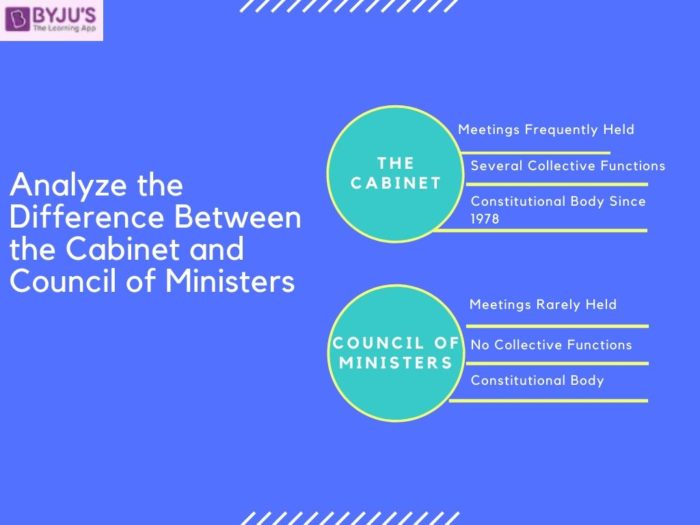The Prime Minister of India is the deciding authority on how the Council of Ministers will be structured. Based on factors such as experience and seniority the Council of Ministers is divided into the following:
- The Cabinet
- Minister of State
- Deputy Minister
- Parliamentary Secretaries
It is not usual for the Cabinet and Council of Ministers to be confused with one another, the only similarity is that they both report to the Prime Minister. There are other factors that make them different from each other.

This article highlights what those key factors of difference between the Cabinet and Council of Ministers within the context of the IAS Exam
Aspirants can find more Difference Between Articles, by visiting the linked page
The differences between a Cabinet and Council of Ministers are given in the table below:
Differences between Cabinet and Council of Ministers
| Cabinet |
Council of Ministers |
| The cabinet consists of many senior ministers who hold important portfolios such as defence, home affairs, education etc. | They consist of Cabinet Ministers, Deputy Ministers and Ministers of State |
| It was conferred the status of a constitutional body after the passing of the Constitutional Amendment Act of 1978 (Also Known as 44th Amendment) | It is a constitutional body |
| The Cabinet consists of some of the most experienced ministers. Thus the Prime Minister seeks their advice on important matters. The decisions of the cabinet are binding to all ministers | It is up to the Prime Minister to consult with the council of ministers or not when it comes to making important decisions |
| It enforces the collective responsibility of the council to its members | It enforces collective responsibility to the lower houses of the parliament |
| The Cabinet meets as frequently as possible to formulate policies and to decide on certain matters of national importance | The meetings between the council of ministers are rare. |
| The size of the cabinet is about 15-20 ministers | The council of ministers usually consists of about 60 to 70 ministers of the government. |
The Cabinet and Council of Ministers are both important concepts in the Polity segment of the UPSC Exams. The following links will help in studying this segment along with giving more detailed information about the above concepts
- Prime Minister and Council of Ministers
- Difference Between Lok Sabha and Rajya Sabha
- Difference Between Legislative and Executive
- Chief Minister and Council of Ministers
- List of Indian Prime Ministers
- Cabinet Ministers of India
- Indian Polity Notes for UPSC
- Important Amendments of the Indian Constitution
- Constitution of India
- Polity Syllabus and Strategy for UPSC
- 100 Difference Between Articles for UPSC
Difference Between Cabinet and Council of Ministers- Download PDF Here
Frequently Asked Questions about Cabinet and Council of Minister
What is meant by Council of Minister?
Who is a cabinet minister?
Candidates can find the general pattern of the UPSC Exams by visiting the UPSC Syllabus page. For more articles and exam-related preparation materials, refer to the links given in the table below:
Related Links


Comments